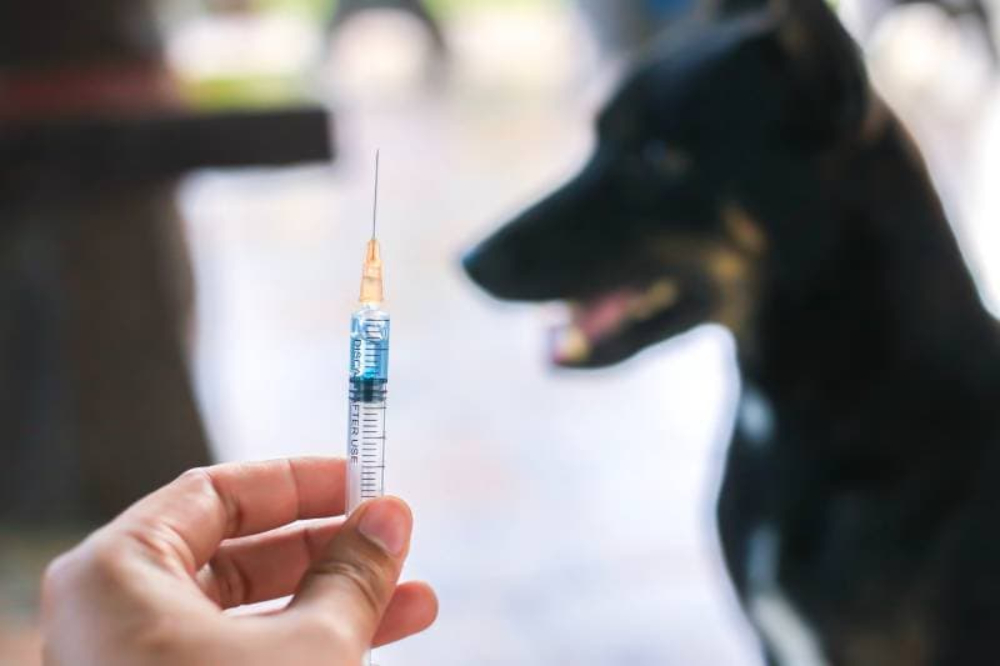If rattlesnakes live in your area or you frequently travel to regions inhabited by them, you should be aware of the huge risk they pose to your dog. Rattlesnakes pack a potent venom that can be fatal to your dog, and unexpected bites can end in long-term damage or tragedy for the unwary traveler’s pooch. Warmer months are especially thick with rattlers, making it even more vital to be on the lookout for them while you’re out.
While you can’t get rid of all rattlesnakes, thankfully, there are ways you can protect your best four-legged friend on the go where the rattlesnakes live! Join us below as we talk about the danger that rattlesnake venom poses to your paw-some furry friend, as well as effective ways to protect them.

Before You Begin
Rattlesnake venom injected by a rattlesnake’s hollow fangs quickly travels through the body, wreaking havoc on countless bodily functions and attacking organs. If allowed to run its course, rattlesnake venom can kill within hours depending on the severity of the bite. There is an antidote for rattlesnake venom, but due to the remote regions they often live in, you may not have access to veterinary care as soon as the bite occurs. The best prevention is preparation in this case, and our tips below will reflect that.
The 5 Tips to Protect Your Dogs From Rattlesnakes
1. Learn the Signs
You may not be there when a rattlesnake bites your dog, so it’s important to know the signs that it happened so that you can seek immediate veterinary attention. Be aware that the effects can sometimes be delayed, so what may seem like a mild problem can quickly turn worse without treatment.
- Seeing puncture wounds
- Redness, pain, and swelling
- Restlessness and pacing
- Panting
- Vomiting
- Drooling/frothing
- Shaking/seizures
- Incoordination
- Diarrhea
- Respiratory troubles
If you notice any of these signs, see a vet immediately.
Did you know you can speak to a veterinarian without having to travel? Just head over to PangoVet. It's our online service where you can talk to a vet online and get the advice you need for your pet — all at an affordable price!

2. Leash Up
Letting your dog off leash allows them some freedom but also opens them up to risks like rattlesnake bites. Most rattlesnake bites tend to happen around the face, so not letting your dog’s nose around everywhere can drastically slash the risk of ever encountering a rattlesnake. Choose a non-retractable leash that makes it easier to pull your dog close if you ever hear the telltale rattle when you’re out and about. Keeping your dog in arm’s reach with a leash helps lower not only the chances of getting bit by a snake but also the risk of being cut or poked by unfriendly flora in the wild.
3. Get Your Dog the Rattlesnake Vaccine
The rattlesnake vaccine can help bolster your dog’s immune system against the possibility of a bite in the future. It’s not foolproof and doesn’t eliminate the possibility that your dog will get bitten but can help lower some of the risk if they do. Dogs that are vaccinated typically experience milder signs and often have an easier time recovering with prompt medical treatment. If you expect to take your dog somewhere where rattlesnakes live, we strongly recommend you get them the rattlesnake vaccine. Ask a vet for more details!

4. Avoid Brush Where Rattlesnakes Live
Rattlesnakes tend to live near brush and underneath rocks. Remove places they can live near your property by trimming or outright removing brush and picking up big rocks. Exercise caution and use tools to flip over these rocks so you don’t get bit by a sleeping snake. Out in nature, lead your dog away from wooded areas with brush that could harbor rattlesnakes and stick to established trails when possible. By avoiding the places they live and removing appealing hiding spots, you’re more likely to avoid encountering rattlesnakes and keep your dog safe.
5. Act Decisively in Case a Bite Occurs
Sadly, prevention doesn’t guarantee that your dog will never get bitten by a rattlesnake. In case the worst happens, you need to remain calm and act quickly to get your dog immediate medical attention. If possible, you can take a picture of the snake for positive identification, but make sure your dog is okay first. If you have one handy, you can apply an ice pack or something cold to the site of the wound while you get your dog to the nearest emergency animal clinic ASAP.
The vet will be able to diagnose the severity of the bite, including how much damage has been done, and administer antivenom to counteract the venom. The sooner your dog gets the antivenom, the better their chances of making it through with minimal long-term damage.


Wrapping Up
Rattlesnakes can be deadly to your dog and even cause long-term side effects, making prevention your best ally. Use a leash at all times when going through rattlesnake-infested territory, stay away from likely hiding places like brush or rocks, and get your dog the rattlesnake vaccine to help them fight off the effects of a bite in case it happens. In the event of a bite, stay calm as a cucumber and get your dog to an emergency center as soon as possible!
- See also: Rattlesnake Training for Dogs
Featured Image Credit: Hanna Taniukevich, Shutterstock


















